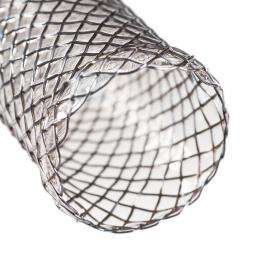If a person‘s windpipe is constricted, an operation in which the surgeon inserts a stent to enlarge the trachea is often the only way to relieve their respiratory distress. But this grid-like implant can slip out of position, closing off the windpipe altogether. Researchers are working on a special surface coating for the stents to keep them in place.
When coronary blood vessels are constricted, cardiologists try to prevent a heart attack by widening them with small grid-like implants called stents, which stabilize the veins and arteries, improve the flow of blood and prevent vascular obliteration. A lesser known fact is that stents can be used to treat pathological constriction of the windpipe. This kind of respiratory stenosis, which may be caused by tumors, chronic infections or congenital deformities, can be life-threatening. The metal or plastic stents are designed to enlarge the trachea and prevent it from closing up altogether.
But complications can arise when the implants are inserted. Firstly, there is the danger that the stents will shift, thus partially or completely obstructing the respiratory tract. Secondly, bacteria can colonize the stents and trigger pneumonia. The reason for this is that the stents have no barrier-forming cells of the kind usually present in the respiratory system, whose task is to fend off bacteria and inhaled substances such as particulate. “The windpipe has an important barrier function, with goblet and cilia cells purifying the inhaled air. It is very important that cells like these can adhere to the stents so as to maintain the air-purifying effect of the damaged section of the windpipe and to promote incorporation of the stents in the surrounding tracheal tissue,” says Dr. Martina Hampel, a scientist at the Fraunhofer Institute for Interfacial Engineering and Biotechnology IGB in Stuttgart. Together with Prof. Dr. Thorsten Walles, head of the department of thoracic surgery at the University Hospital of Würzburg and a visiting scientist at the IGB, Dr. Hampel and her team took part in the “REGiNA” project, the goal of which was to develop surface coatings that enable the stents to be incorporated in the surrounding tissue, thus reducing the risk that they will move. REGiNA, a German acronym for Regenerative Medicine in the Neckar-Alb and Stuttgart Region, is funded by the German Federal Ministry of Education and Research BMBF.
Bioactive coatings lower the risk for patients
The scientists used stents lined with a polyurethane (PU) film, which were produced by Aachen-based Leufen Medical GmbH. In the ensuing tests, a wide variety of different coatings were applied to the PU film: In addition to synthetic polymers composed of organic acids, the researchers also tried out biological proteins such as fibronectin and type-I collagen. The coating was modified again using plasma technology, with vacuum-ionized gas being used to treat the surface. The experts used an untreated PU film for control purposes. “In order to find out which of the surface coatings was the most suitable, we brought both lab-cultivated cell lines and human primary tracheal epithelial cells into contact with the films in cell culture vessels. What we wanted, of course, was for the primary respiratory cells from human tissue to attach themselves to the film,” explains Hampel. The researchers achieved their best results with the protein-coated film, on which the primary tracheal epithelial cells grew particularly well and multiplied. “The respiratory cells proved to be more vital on bioactive films rather than on ones treated with plasma. By contrast, polymer-coated film turned out to be completely useless,” says Hampel.
The laboratory tests have since been completed, and animal tests are in preparation. If the good lab results are confirmed in these tests, the next step will be to conduct clinical trials of the modified stents at the Schillerhöhe specialist lung clinic, part of the Robert Bosch Hospital. “We hope that, within just a few years, our well-tolerated, cell-compatible surface coatings will be used for other biomedical prostheses such as pacemaker leads, tooth implants and replacement joints,” says Hampel.
Provided by Fraunhofer-Gesellschaft




















